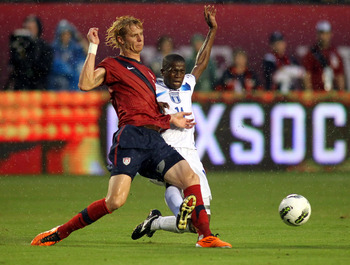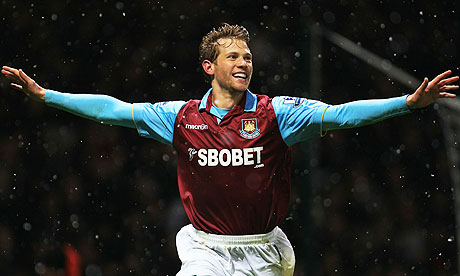
Forwards: Jozy Altidore, Charlie Davies, Brian Ching, Clint Dempsey
Midfielders: Landon Donovan, Michael Bradley, Maurice Edu, Benny Feilhaber, Jose Francisco Torres, Ricardo Clark, DaMarcus Beasley, Alejandro Bedoya
Defenders: Carlos Bocanegra, Oguchi Onyewu, Jay DeMerit, Jonathan Spector, Jonathan Bornstein, Clarence Goodson
Goalkeepers: Tim Howard, Marcus Hahnemann, Brad Guzan
The Orebro midfielder didn't look out of place one bit against Honduras or Holland, which is quite an accomplishment in and of itself for a 22 year-old who has, all together, only played a little over and hour on the field in a U.S. Jersey( Bedoya turns 23 this April).
As far as the forwards go, it would take an injury setback to keep Charlie Davies off the roster, and seeing as how he's progressing extremely well, I'd say he's on. If he can't secure playing time or form for Sochaux then that might be a concern, but considering the comments by his manager saying he'll use him when he's available, I'd say Davies will get at least one chance to impress, which was about all he needed in the Confederations Cup. Herculez Gomez has been in good form( 10 goals in 14 games) for Puebla and if he keeps it up, Brian Ching, who is injured, might not have a spot on this team. Conor Casey is another option who is vying for the backup target forward spot, but, apart from his heroics against Honduras, Casey has been pretty average.
As far as the lineup goes, I would imagine this to be the safest bet:
------------------------Dempsey-----Altidore-------------------
Donovan------------------Edu-------Bradley-------------Holden
Bocanegra-------------DeMerit-----Onyewu-------------Spector
-------------------------------Howard---------------------------
I wouldn't bet against Holden getting back in time, but I wouldn't count on him getting fit and in form before the England game. Edu has been getting time and playing well for Rangers, so I would start him over Ricardo Clark.
A lineup I'd like to see? Something like this:
--------------------------------Altidore-------------------------------
Davies-------------------------Dempsey---------------------Donovan
-------------------------Edu--------------Bradley--------------------
Bocanegra---------------DeMerit-----Onyewu-------------Cherundolo
--------------------------------Howard-------------------------------
I think this lineup is conducive to the style that the USA plays. It gives the Yanks some pace and skill on the flanks with Donovan and Davies and encourages counterattacks, like the legendary one against Brazil. Dempsey is put in a position to create and get close to goal, two things he has proven to be very dangerous at. Morever, he doesn't have quite as much defensive responsibility
as he did on the right/left in a 4-4-2. Instead, they're given to Davies, who actually has the work rate to complete them, not to mention the pace to get back into the attack quickly enough when the USA does win the ball. I know that this formation moves Davies away from Altidore, but if you look at most of the USA's best goals at the Confederations Cup, Davies isn't anywhere near Altidore. On the first goal against Spain, Davies brings down a pass from Michael Bradley out wide on the left for Clint Dempsey, who touches it back to Davies, who in turn plays it for Dempsey, who.... well, you know the rest. On the first goal against Brazil, Dempsey and Davies switched places before Spector whipped in the cross, putting Clint in the center, and Davies on the right. On the second goal against Brazil, Davies is out wide on the left and leading the counter attack with Donovan. My point is that the USA my have played a 4-4-2 in the Confederations Cup, but it looked like a 4-2-3-1 at times, and those times seemed to come when the USA scored. Coincidence? I would think not. Even in the El Salvador game, Davies would drift to the right and left and take players on, like his lane-change stepover he did on the left flank before feeding Dempsey for a missed chance. In the Honduras game, Davies fed Donovan, who had to take the playmaker role since Dempsey was injured, who played through Casey for a goal. Now, don't get me wrong. Clearly Altidore and Davies play well together and are good at breaking down defenses, but I don't really expect Davies to just sit on the flank if he wasn't going to do the same thing at the striker position. Davies, Donovan, Dempsey and Altidore would swivel spots all the time during the Confederations Cup and Qualifying. Dempsey started on the right flank against Spain, but had switched with Donovan after a corner kick and thats why he was on the left for the goal. What I'm saying is that this is the most frequent shape the USA should take in it's matches because it fits their style. Of course, if my thoughts on the front four of Altidore, Davies, Donovan and Dempsey floating around the midfield and attacking third are correct, then it really doesn't matter what formation we put them in because they'll just keep rotating until somebody can find a sweet spot in the defense to exploit and a way to exploit it, i.e. Sergio Ramos against Spain, Gomaa against Egypt.
France struggled in the World Cup in the group stage just like the USA. , but a change in style to a 4-2-3-1 with Zidane as the playmaker, Henry as the lone striker, Ribery and Malouda on the flanks, Vieira and Makelele as the central midfielders, and placing David Trezeguet on the bench, trashing the 4-4-2. The change worked; the French beat Spain(3-1), Portugal(1-0), and Brazil(1-0) on the way to the final, and, in my opinion, they probably would have won if it weren't for a famous shiny head. The French played a pretty similar style to the USA, in that they don't focus on possession, are a very direct team and use a team effort to press the opposition, win possession which is where Vieira and Makelele come in handy, and then get the ball into it's dangerous attacking players whichever way is possible( a defense splitting pass, a long ball, build up through the midfield, corner kicks, crosses from full backs) . Two goals against Spain(Ribery, Zidane) were created through interceptions in the midfield. What I'm saying is that the USA's style managed to work against Spain TWICE and got the national teams who used them to a FIFA Tournament final. Coincidence? Maybe, but I don't think so. Davies is back in full training so this is very much possible.
In general, the USA seems to be stronger than it has been in a while, and will continue to strengthen themselves as players like Charlie Davies, Oguchi Onyewu, Clint Dempsey, and Stuart Holden continue to work themselves back from the injury list. The real question is whether they can translate individual strength into the team strength that took them to the Confederations Cup final.








